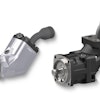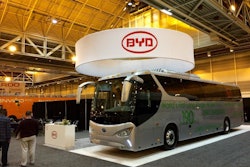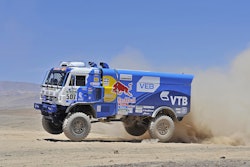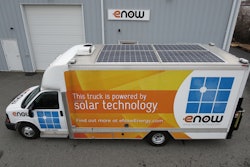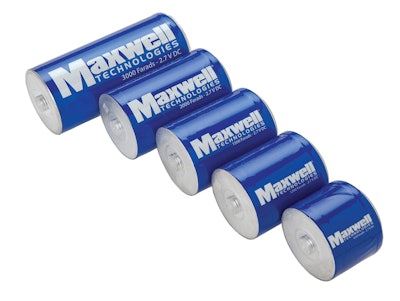
Once every three years, APTA (American Public Transportation Assn.) EXPO (event information, 12029847) arrives in a major U.S. city to showcase the products, technologies and services available in public transit. The 2014 show was hosted in Houston, TX, and several vehicle and advanced technology announcements were made in line with cleaner air and fuel efficient transportation systems.
Transit buses, while they help to relieve traffic congestion, are some of the most polluting vehicles on the road, and they run all the time. Many vehicles only get three miles per gallon in the case of compressed natural gas (CNG), and maybe four or five miles per gallon for diesel and diesel hybrid.
“In the areas we care about the most—the areas where we live and where we work, where our kids go to school, where our hospitals are, our great museums, our airports—those are our most emission-sensitive areas and those routes are currently served by some of the dirtiest vehicle technology in the market. Our goal, and we think this is entirely possible, is to move toward a future where fossil fuels are not consumed in cities for transit,” commented Ryan Popple, CEO of Proterra Inc., during a video interview at APTA EXPO 2014.
Proterra (company information, 12003190) is a designer and manufacturer of zero-emission vehicles. “We have a very simple mission at Proterra. Our goal is to help cities move away from fossil fuel usage entirely for their urban transit fleets,” Popple continued. “The reason we’re so excited at this show, the 2014 APTA EXPO, is that we think this is the first year that it’s really obvious that that’s where things are going. It’s not just Proterra. There are four or five other electric transit vehicles here, and for the first time I think the industry is seeing the potential of something other than a dependency on fossil fuels.”
One of those other companies was BYD (Build Your Dreams) Co. Ltd. (company information, 12023179), a Chinese corporation specializing in rechargeable battery technology for IT, automotive and new energy. Its BYD Auto brand develops innovative electric vehicles such as the BYD 40- and 60-foot articulated battery-electric buses which utilize the company’s iron-phosphate “Fe” battery technology. BYD’s iron-phosphate “Fe” battery technology features life cycles up to 10,000 cycles while maintaining a capacity of over 70%, and the battery can be recycled when its usable life is met.
Nova Bus (company information, 12011357), part of the Volvo Group, displayed its electro-mobility solution at APTA EXPO 2014 which features an en-route fast-charging system (learn more, 12029883). “At Nova Bus, we believe transit systems need to be efficient and reliable, but we also believe it should be sustainable,” says Jacques Bergeron, Vice President Engineering, Product Development & Procurement. “Our goal is to develop a reliable solution that is adapted to North American conditions and is based on a modular and versatile system. Transit authorities will be able to select the electric configuration that best suits their operational needs.”
All-Electric Buses
In September, Proterra Inc. launched its second generation all-electric bus in a 40-foot V2 model (vehicle information, 12029784). It features a fast-charge system that keeps the bus on the road with no requirement to take it out of service for long charging periods, one-step access for ease-of-maintenance and industry-leading ergonomics.
“A charge system is any means or mechanism for putting energy back into the bus,” explained Seamus McGrath, Charge Systems Manager for Proterra, during the same video interview. The Proterra V2 uses an overhead charge method that charges a bus from empty to fully charged in about 10 minutes through a charge of 450 kW. “With respect to that, typical route charge recovery time is about four minutes; just like a car, you don’t run it until empty and then fill it up.”
Proterra’s fast charge system is enabled through its lithium titanate battery chemistry, which allows the vehicle to run with fewer batteries on board for a lighter and more efficient system. Besides fewer batteries, the vehicle body features a lightweight, fiberglass balsa wood construction.
The drivetrain and propulsion system has demonstrated 20.8 miles per gallon equivalent (MPGe) and over 17 MPGe during typical fleet operation. The buses Proterra is able to provide offer zero tailpipe emissions while simultaneously reducing CO2 emissions by 180,000 pounds of CO2 equivalent greenhouse gases (GHG) per year versus a CNG-powered bus. Download a spec sheet of Proterra’s all-electric 40-foot bus at 12029784.
The BYD Electric Bus offerings include a 40-foot model with a range of 155+ miles per charge, while the 60-foot articulated model can get upwards of 170 miles per charge. Bi-directional AC charging allows full charging from 0 to 100% SOC within 5 hours. Energy recovery and battery recharging is accomplished through a regenerative braking system. High-efficiency, in-wheel traction motors allow for ultra-low floor loading options and simplified maintenance.
Nova Bus’ LFSe all-electric bus option is based on the company’s existing and proven LFS platform. The electric bus system reduces energy consumption by 80% compared with conventional diesel buses. The innovative solution minimizes the weight and maximizes the loading capacity by removing the all charging element from the bus and optimizing the number of batteries.
An overhead inverted pantograph, conceived by Siemens, creates an integrated and efficient transportation infrastructure power distribution system. Robert Hardt, President and CEO, Siemens Canada, says, “As cities throughout North America continue to grow, the need for efficient and clean transportation solutions has become critical. At Siemens we are committed in finding new and innovative ways of to meet these needs, and the High Power Charger is a great example of this commitment.” Download a spec sheet of Nova Bus’ all-electric LFSe bus at 12029909.
Batteries and Fuel Cells
While OEM BYD may have its own internal battery competency, most rely on battery and fuel cell technology experts to co-develop a battery electric powered transit bus. At APTA EXPO 2014, these battery experts were prevalent, only reaffirming the industry's investment and confidence in this technology as the next generation of clean public transit.
Ballard Power Systems, Inc. (company information, 12029987) is a global leader in PEM (proton exchange membrane) fuel cell technology. Ballard’s PEM fuel cells combine hydrogen fuel and oxygen from the air to produce electrical energy efficiently, quietly and without combustion. The only by-products are water and heat. Its clean energy fuel cell products enable optimized power systems for a range of applications, not just for the bus market.
Its FCvelocity–HD6 fuel cell power module for bus applications has over 200,000 operation hours logged in the field all over the world. This sixth-generation model can deliver 75 or 150 kW of power, and features a control unit to interface with a system controller, allowing it to be a true plug-and-play product for any fuel cell bus platform.
Another player in the battery and ultracapacitor manufacturing market is Maxwell Technologies Inc. (company information, 10325608) who showcased its latest K2 Series of ultracapacitor cells (product information, 10325612) at APTA EXPO 2014.
Unlike batteries, Maxwell ultracapacitor products store energy in an electrical field that is larger than that of a capacitor – meaning greater energy storage capacity. This electrostatic energy storage mechanism enables ultracapacitors to charge and discharge in as little as fractions of a second, perform normally over a broad temperature range (-40 to 65 C), operate reliably in hundreds of thousands or more duty cycles and resist shock and vibration.
The 2.85-volt, 3400-farad ultracapacitor cell increases the range of available specific power and stored energy in the industry-standard 60 mm cylindrical “K2” form factor, and features DuraBlue shock and vibration technology to the requirements of global transportation applications.
APTA EXPO 2014 proved to be an instrumental stepping stone in determining a solidified, unified direction for the development of clean public transportation. As battery technology continues to advance and more companies and transit authorities get on board (figuratively) with all-electric bus development, there is no telling what vehicles will be proven and on display at APTA EXPO 2017.


